Children's Book How-to
-
The Uncompromising Quest for Quality in Children’s Picture Books: A Beginner’s Guide
As you navigate the challenges of creating your first children’s picture book, remember this: do not compromise on quality. It may be tempting to take shortcuts, but each instance of compromise chips away at the integrity of your work. Upholding unwavering standards is not just about the first book; it’s about setting the standard high for the entire picture book industry.
Importantly, as a beginner, resist the notion that you should be excluded from delivering a high-quality picture book. Every author and illustrator, regardless of experience, can create work that meets the highest standards. Your unique perspective and fresh ideas can bring a new and vibrant energy to the industry. Embrace the challenge and view it as an opportunity to contribute something exceptional to the world of children’s literature.
By refusing to compromise on quality, you not only elevate your work but also challenge the misconception that beginners are exempt from producing top-notch content. Imagine a community where every creator, regardless of their experience level, is dedicated to delivering excellence. Your commitment to quality becomes a catalyst for positive change and progress within the industry.
Here are some images of Zanariah Salam’s work in progress. She is fully dedicated to creating a quality picture book, maintaining a consistent style throughout. Photos are by Zanariah Salam.
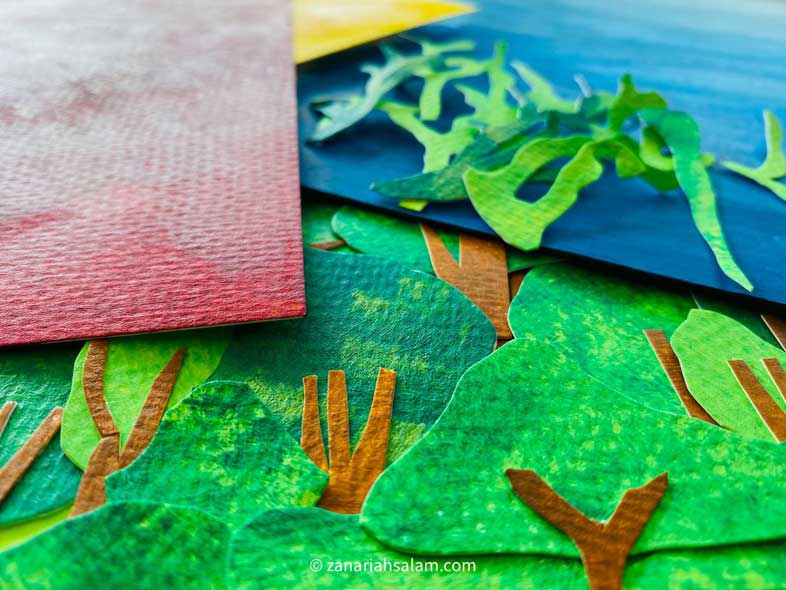
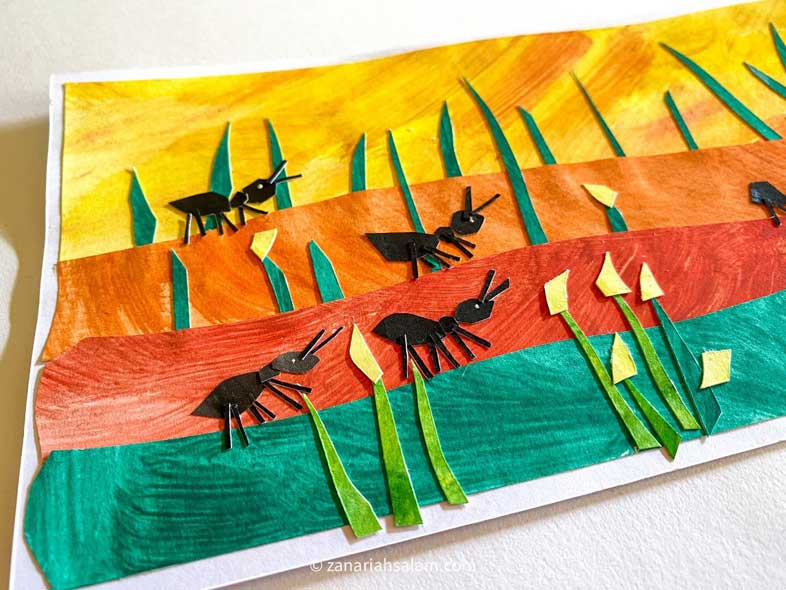
In conclusion, as you embark on your journey into the enchanting world of children’s literature, remember that an unwavering commitment to quality is the foundation upon which lasting success is built. Your dedication to creating high-quality children’s picture books not only ensures a positive experience for young readers but also sets the stage for a fulfilling and enduring career while challenging the belief that beginners cannot contribute significantly to the excellence of the picture book industry.
Here are some tips you can use as guidelines:
- Professional Advice Matters: Once you’ve completed your mock-up, seek guidance from professionals in the industry. Engage with experienced authors, editors, or literary consultants who can provide insights and constructive feedback to refine your work further.
- Consistency in Style: Maintain consistency in your writing and illustration styles throughout the book. A cohesive and unified approach contributes to a polished and professional final product.
- Iterate and Refine Illustrations: If you are illustrating your book, iterate and refine your illustrations. Ensure that each image complements the text and adds depth and visual interest to the storytelling.
- Be Open to Revision: Be open to the revision process. It’s a natural part of creating a high-quality picture book. Embrace feedback, iterate on your work, and be willing to make changes that enhance the overall impact of your story.
- Professional Advice Matters: Once you’ve completed your mock-up, seek guidance from professionals in the industry. Engage with experienced authors, editors, or literary consultants who can provide insights and constructive feedback to refine your work further.
-
Spoonie’s Journey: A Tale of Survival and Migration
As the proud author and illustrator, I’m thrilled to share my long overdue piece of heart with you—Spoonie’s Journey.
Spoonie’s Journey is a reflection of the real challenges faced by the spoon-billed sandpiper—a species teetering on the brink of extinction. As we delve into Spoonie’s sojourn, we’re reminded of the delicate balance of nature and our responsibility to preserve habitats, ensuring the survival of these remarkable creatures and their extraordinary migratory journeys.

In the heart of the vast tundra of northeast Russia, a tiny spoon-billed sandpiper named Spoonie is born on a warm summer’s day. With a beak shaped like a spoon, Spoonie navigates the soft muddy land, scooping up spiders, flies, and mosquitoes—the perfect feast for this little adventurer.
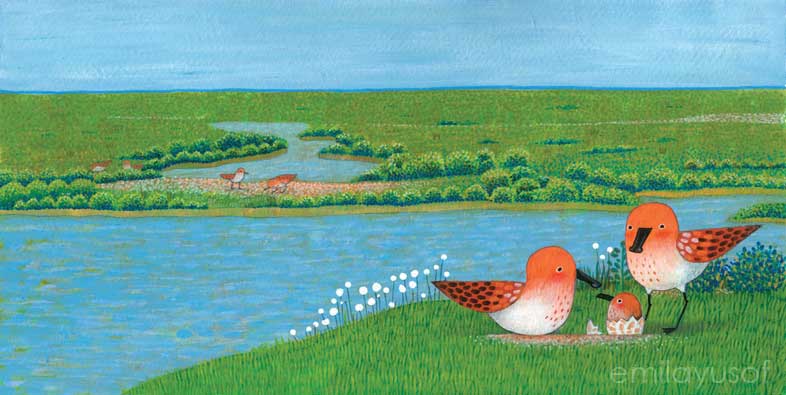
As the days grow colder, Spoonie joins his parents to embark on a mesmerizing migration, soaring over lands and oceans. They stopped at Yubu Island in Japan and sunny wetlands of Malaysia before flying to Australia and the Yellow Sea in China, before finally reaching the beloved tundra.
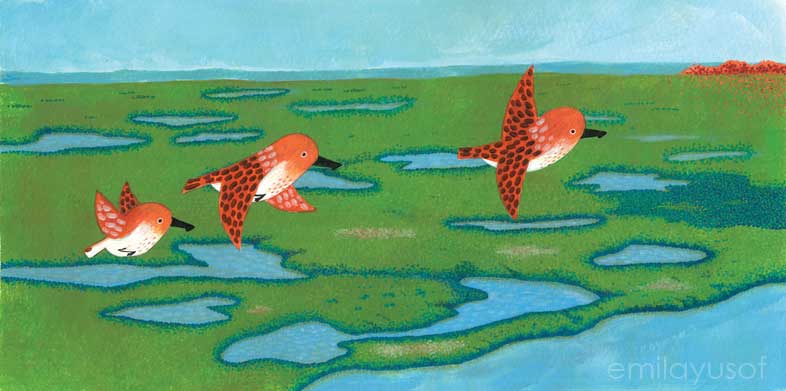
SPOONIE’S JOURNEY
ISBN 9789672384519
Publisher: Oyez!Books
Size: 21 cm x 22 cm
Year: 2022 -
Basic Guide to Crafting Captivating Illustrations for Children’s Picture Books
Creating illustrations for children’s picture books is a delightful blend of creativity, storytelling, and visual artistry. To craft images that captivate young readers, consider the following key elements:
1. Vibrant Color Palette: Choose bright and appealing colours that resonate with the target age group, evoking emotions and creating a lively atmosphere.
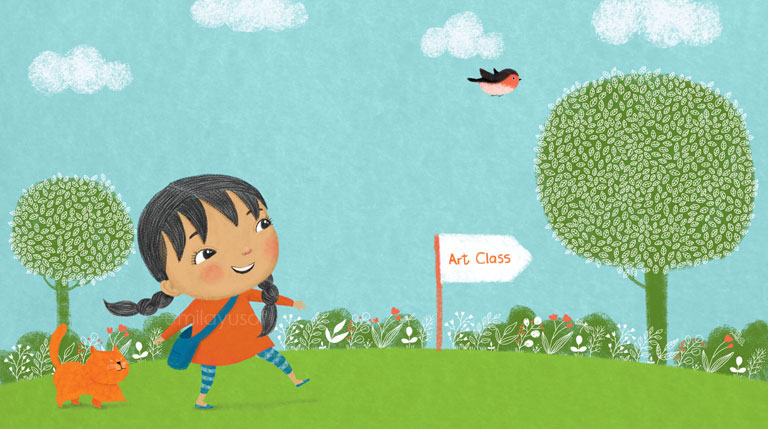
Dina’s Art Class, published by Oyez!Books 2. Character Design: Develop characters with distinctive features, expressions, and relatable traits to foster a connection with young readers.

From left: Jingga and Dina (Dina’s Art Class, Oyez!Books), Jep (Umaral, Oyez!Books), Pipa, Wigel & Uncle Spruce (Pipa Gadis Kertas, soon DBP). 3. Consistent Style: Maintain a consistent illustration style throughout the book to provide a cohesive and memorable visual experience.
4. Scale and Perspective: Experiment with varying scales and perspectives to add visual interest and dynamic elements to the illustrations.
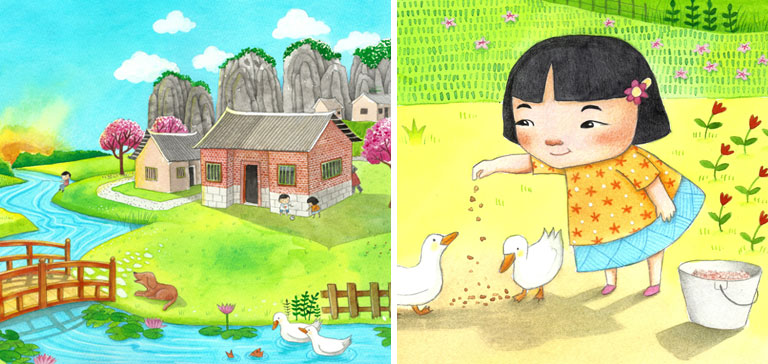
Over The Bridge (Author: Tang Su Lan, Illustrator: Emila Yusof) Hunan Juvenile & Children’s Publishing House) 5. Emotional Resonance: Infuse characters and scenes with emotions to create a deeper connection with young readers.
6. Interactive Elements: Integrate interactive or hidden details that encourage reader engagement, making the experience more enjoyable.
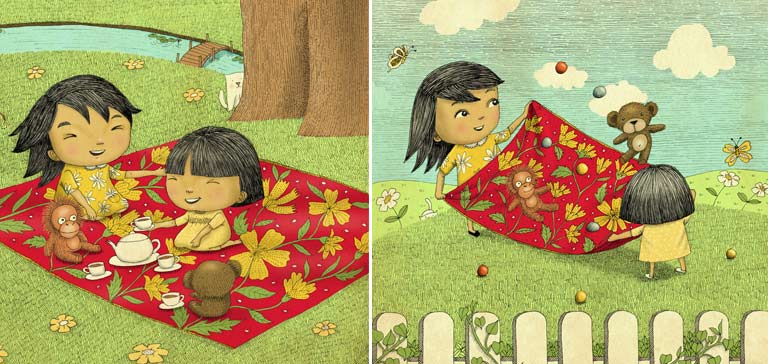
Notice the cat? It appears on most pages. Two Sisters, One Sarong (Author: Lorraine Yoong, Precious Pages Resources) 7. Cultural Sensitivity: Represent diverse cultures accurately and respectfully in illustrations to promote inclusivity.

Wu Zetian, China and Nawang Wulan, Indonesia (Legendary Princesses of the World, unpublished) 8. Typography Integration: Explore ways to integrate typography creatively with illustrations, enhancing the overall visual appeal.
9. Symbolism and Themes: Include subtle symbolism or thematic elements that enhance the story’s underlying message.
10. Dynamic Poses: Experiment with dynamic poses for characters to convey energy and movement, keeping the visual storytelling lively.
11. Humor and Playfulness: Infuse a sense of humour and playfulness into the illustrations, adding whimsical details for added joy.
12. Visual Consistency Across Series: Maintain visual consistency if the picture book is part of a series, building a recognizable brand for readers.
13. Imagination and Creativity: Foster imagination and creativity through illustrations that spark young readers’ imaginative thoughts.
14. Illustration Techniques: Explore a variety of illustration techniques to add richness and visual interest to your artwork. Experiment with techniques such as watercolour, digital illustration, mixed media, or hand-drawn elements. Each technique brings its unique qualities, allowing you to create a diverse visual experience within the pages of the picture book. Consider how different techniques can enhance specific aspects of the story or evoke particular emotions, providing a dynamic and engaging visual journey for young readers.
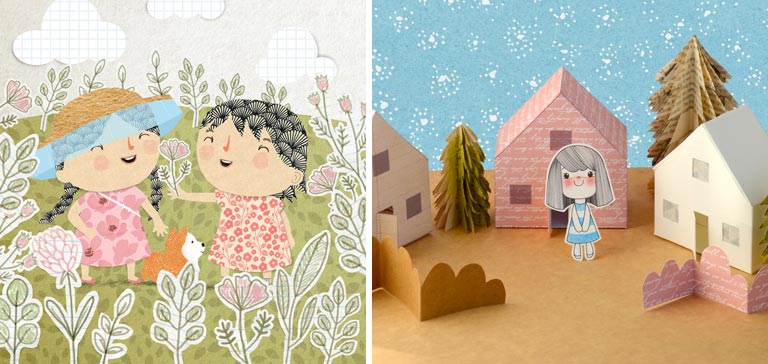
Left: Digital Collage with scanned and vector illustrations, from Grandma’s Flowering Tea (Oyez!Books). Right: Paper-based objects in the Diorama setting, captured with camera from Pipa Gadis Kertas (soon by DBP) 15. Adaptability for Different Formats: Ensure illustrations remain impactful and clear in various formats, including e-books or interactive platforms.
16. Educational Opportunities: Integrate educational elements into illustrations where applicable, creating hidden details for young readers to learn from.
17. Inspiration from Everyday Life: Draw inspiration from everyday life, nature, and the target audience’s experiences to infuse authenticity into the illustrations.
18. Testing with the Audience: Test illustrations with the target audience to gather insights and ensure the visual elements resonate effectively.
In essence, creating illustrations for children’s picture books is a dynamic and imaginative process. Embrace experimentation, stay open to feedback, and enjoy the journey of bringing stories to life through visually captivating art. I will add more of my illustrations when time permits.
-
Unveiling the Art of Becoming a Children’s Picture Book Author and Illustrator
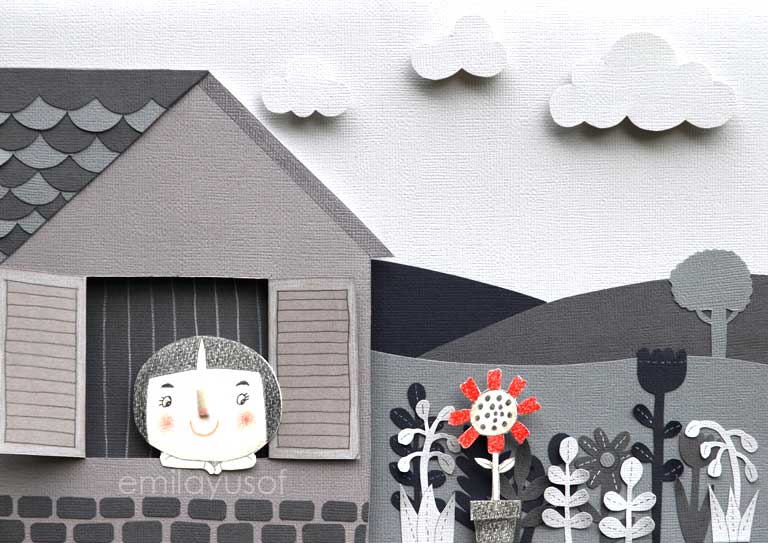
Daydream by Emila Yusof, 2018 (unpublished) Embarking on the journey to become a children’s picture book author and illustrator is a creative odyssey that combines storytelling finesse with artistic prowess. Whether you’re drawn to the enchanting world of whimsical narratives or captivated by the allure of vibrant illustrations, the path to crafting picture-perfect stories for young readers involves a blend of creativity, skill development, and unwavering persistence.
The Art of Writing:
- Understand the Audience: Before putting pen to paper, take the time to understand the dynamic audience you’re catering to. Delve into the intricacies of the chosen age group, considering their interests, language proficiency, and developmental stage.
- Read Extensively: Immerse yourself in the world of children’s literature. Read a diverse array of children’s books to grasp different styles, genres, and storytelling techniques that resonate with young readers.
- Develop a Unique Voice: Discovering your unique writing voice is pivotal. Aim to create a narrative that not only engages but also captivates young minds. Your distinctive voice is what will set your stories apart.
- Craft a Compelling Story: Craft a narrative that boasts strong characters, a clear plot, and a relatable theme. Children’s books often convey a lesson or message, so weave these elements seamlessly into your storytelling.
- Consider Picture Book Structure: Understanding the structure of a picture book is crucial. With a limited number of pages, you must master the art of crafting a beginning, middle, and end, leaving ample room for illustrations to complement the text.
The Craft of Illustrating:
- Develop Your Art Skills: Artistic prowess is the cornerstone of being a children’s book illustrator. Dedicate time to honing your skills, experimenting with various styles, and discovering the visual language that complements your storytelling.
- Understand Page Layout: Picture books demand a keen understanding of page composition and layout. The marriage of text and illustrations should create a seamless and visually compelling reading experience.
- Create a Portfolio: Compile a portfolio showcasing your best work. This portfolio will serve as your visual resume when approaching publishers or literary agents, offering a glimpse into your artistic style and storytelling capabilities.
- Consider Your Artistic Style: Developing a consistent artistic style is paramount. Your illustrations should harmonize with your writing, creating a cohesive and visually appealing narrative for young readers.
Getting Published:
- Research Publishers: Explore publishers specializing in children’s books. Thoroughly research their submission guidelines and tailor your submissions to align with their preferences.
- Consider an Agent: While not obligatory, having a literary agent can be advantageous. Agents possess industry knowledge and can assist in navigating the complex landscape of the publishing world.
- Submit Your Manuscript/Illustrations: Follow submission guidelines meticulously. Some publishers may prefer to review the manuscript first, while others may request a combination of text and illustrations.
- Be Persistent: Rejections are an inherent part of the publishing journey. Use each rejection as an opportunity to refine your work and approach. Persistence and resilience are key attributes on this path.
Marketing and Promotion:
- Build an Online Presence: Create a website or leverage social media platforms to showcase your work. An online presence enables you to connect with your audience and build anticipation for your upcoming releases.
- Engage with the Community: Participate in book events, connect with educators, and librarians, and immerse yourself in the vibrant children’s literature community. Building connections is essential for fostering support and expanding your reach.
- Consider Self-Publishing: If the traditional publishing route proves challenging, explore the option of self-publishing. It provides autonomy but demands a strategic approach to marketing and distribution.
Embarking on the journey to become a children’s picture book author and illustrator requires dedication, continuous learning, and a profound love for storytelling. As you navigate the creative process, relish in the joy of bringing imaginative worlds to life for the delight of young readers. Keep refining your craft, stay persistent, and savour every moment of the enchanting adventure that lies ahead.
-
How to illustrate picture books
 Left: my illustration, right: my student’s illustration (Heidi).
Left: my illustration, right: my student’s illustration (Heidi).Do you want to illustrate children’s or picture books? Here’s a step-by-step guide by me:
1. First and foremost, practice your drawings.
Get yourself a basic sketchbook, a pen and a mechanical pencil (with an eraser on one end). Draw whenever you can; while waiting for the bus, while waiting for a meeting, while cooking, while waiting for food to arrive while eating out, etc. Fill those pages with sketches: characters, be it kids, monsters, animals, buildings or scenery. You can even draw your food.2. Read a lot of children’s books. Study the illustrations.
If your friends buy novels at the bookshop, don’t be shy to buy children’s books for yourself. It’s normal. Tell them Emila buys children’s books too for herself.I can suggest those from Oyez!Books for local children’s books. For international ones, you can browse Kinokuniya shelves and look for Oliver Jeffers, Maurice Sendak, Isabella Arsenault, Beatrix Potter, Rebecca Dautremer, Eric Carle, Quentin Blake, etc. The international ones are expensive but what the heck, for the sake of learning, why not spend money on good books, right?
3. Copy! Copy! Copy!
I don’t mean copy all per se. You can copy Maurice Sendak’s monster’s eyes and put it on Oliver Jeffer’s boy but perhaps with real legs (not stick, hehe), and add a dreamy background like Satoe Tone’s with Mirdinara’s foliage. Soon, you will get ideas on how to create your own. This is only for your learning purpose, not for commercial purpose, ya.4. Practice illustrating words.
You can begin with a word a day then gradually to one paragraph of a story and so on and so forth. You can also illustrate quotes, lyrics, your own retelling of folktales, etc.5. Love what you do.
When you do what you love, it’ll show in your drawings/illustrations.6. Don’t worry about being not perfect.
By doing more drawing practices, you will get better than most other people. You know, I don’t consider myself as a born artist. I have to work hard to make drawings/illustrations I like.7. Upgrade your sketchbook, colour your illustrations.
Buy good sketchbook (with 200gsm paper). I can suggest Monologue Soft Sketchbook or Moleskine Folio or Sketchbook. Get yourself a watercolour, or colour pencils, acrylic, or others. Try those on your sketchbook. This way you will get hands-on experience using colours.8. Find free online tutorials.
Check out Youtube! There are tonnes of free tutorials on how to draw, how to apply a technique, how to use your brush correctly, etc.9. Share your drawings.
Share it with your family and friends. You can share it online as well. Get people to give you constructive comments.10. Join a workshop!
If you think you are ready to illustrate children’s picture book, do join a picture book illustrations workshop, or perhaps join E&E Workshop (Emila and Evi)! We will guide you on the process of how to create children’s book.Pitching your book manuscripts/illustrations to publishers is not included in our workshop but we can help list down those that accept submissions.
-
Writing for picture books
Writing picture books may seem easy but by far, it is the most difficult one.
A novel can have more than 10,000 words but picture book may be only 100 words long (can be up to 1000 words but the less the better). Those words must be well chosen. If you read poetry or haiku, you know the difficulty of containing large thoughts in small spaces.
Here are some guides to help you write:
- Word count. 500-600 words is a good number to aim for. Some publishers accept 1000 words but it is better to keep it up to 600. The standard text is for 32 pages. The prelim, title page, dedication, takes up several pages. This leaves you with 25-28 pages to tell your story.
- Plot. Keep it clear and simple, based on a single situation that involves some action.
- Think visually. As you write, imagine the pictures that could accompany it.
- Pacing: Think about how you’d like the text to be broken up (page-break). It’s very important in a picture book to have a good rhythm, pace, and contain the drama of the page turn.
- Use interesting word. Never look down on the little readers.
- Go straight to your story. There’s no time for introduction or prolog.
- No need to describe things that can be shown in the illustrations. Example: you can write ‘Jenab found a book’ instead of ‘Jenab found a book lying on a bench in a park’. (Illustration: Jenab looking at a book lying on a bench in a park. To show that it is a park, you can illustrate a pond, some ducks, trees, people walking in the background). You get the idea, right?
- Avoid rhyming. Most publishers will remind authors not to rhyme because it will be hard for them to translate it into other languages.
- Read over and over again. Adjust and rewrite as you go until you are sure you can’t make it any better. Leave it for few days, and read again. You might have something to add or delete.
- Themes. Good children’s picture books need strong, universal themes. Examples: acceptance, tolerance, economic disparity, try something new, adventure, animals, gratitude, admitting mistakes, arts, autism, be yourself, courage, bullying, cause and effect, disabilities, friendship, judgement hope, war/peace, bereavement and much more. Ideally, good picture books have the power to change thinking and offer a new perspective.

Books in photo: Thumbelina( Hans Christian Anderson, retold by Brian Alderson/Bagram Ibatoulline), A Child Of Books (Oliver Jeffers/Sam Winston) and You Belong Here (MH Clark/Isabelle Arnault).
Alternatively, you can find these tips in Bahasa Melayu at TabulaKata. Thanks TabulaKata for the feature!